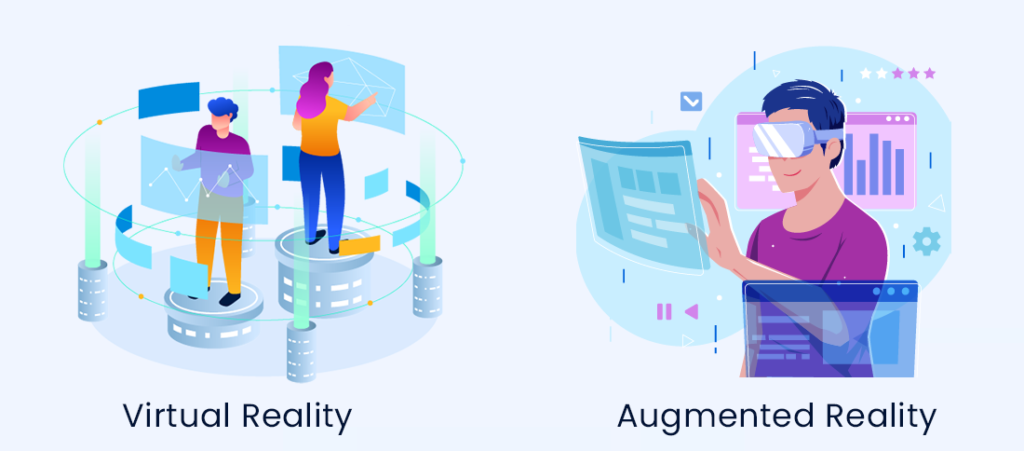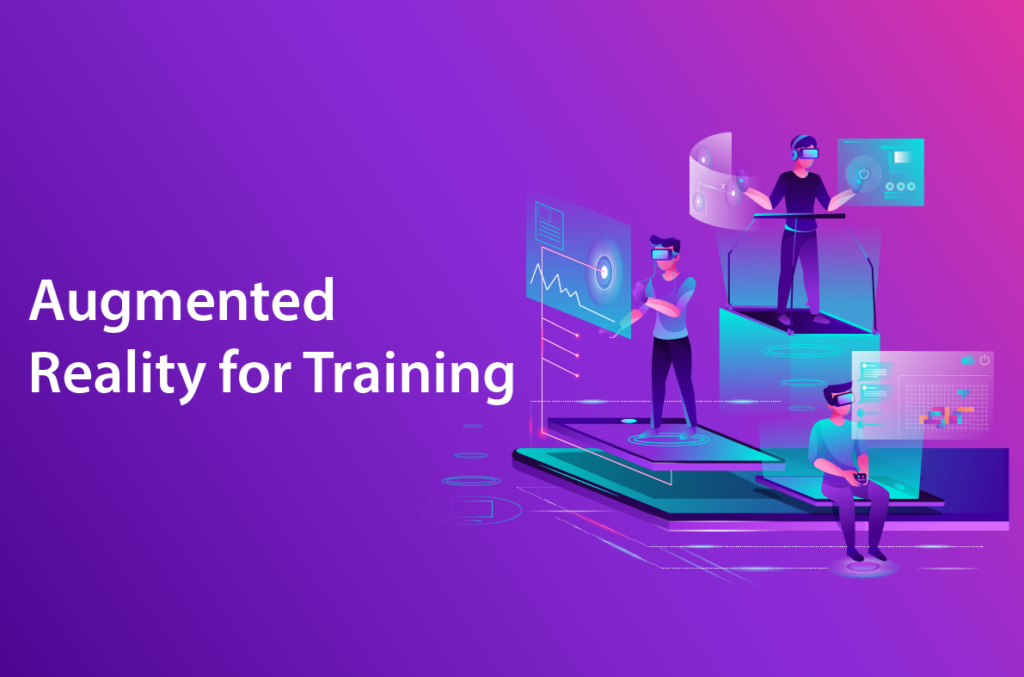Traditional course materials, such as presentations, videos, or eBooks, rarely meet all training requirements and cannot guarantee learning and knowledge transfer to workplace performance. Corporate trainers must develop new strategies and use the latest technologies to create and deliver employees’ high-quality content and maximize the transfer of learning
Augmented Reality (AR) is an innovative technology that can significantly enhance online training.
Augmented Reality (AR) enhances the view of the physical world or artifacts through digital augmentation that may include visual elements, sound, or other sensory stimuli delivered via technology. It is a growing trend among companies involved in mobile computing and business applications.
As per recent data, by 2024, there will be an estimated 1.7 billion mobile Augmented Reality (AR) users worldwide, a rise of 1.5 billion from the 200 million seen in 2015. In 2022, an estimated 1.1 billion mobile AR users will be there worldwide.
Augmented Reality is readily available on computers, mobile, and apps and is already gaining wide acceptance. Some examples include Snapchat Lenses that use AR technology to augment your selfies and AR apps that help you find your car in a crowded parking lot. Various shopping AR apps even let you try on clothes without leaving home.
Corporate learning and development organizations already use AR extensively. For example, companies such as Walmart and Chipotle use AR to impart employee training that includes a hands-on multi-sensory experience resulting in practical training and better results.

Augmented Reality (AR) allows learners to observe and interact with their natural surroundings in new ways. Learners can control and engage in real space by moving material with their finger, hand, arm, or body, rather than using a computer interface to explore and manipulate data.
Virtual Reality vs. Augmented Reality
Augmented Reality improves user experience using the current real-world environment seen through a mobile device camera. It overlays virtual or digital content to supplement the content displayed on the device screen.

Augmented Reality is intermeshed in the actual environment and does not require additional resources for the user experience.
On the other hand, Virtual Reality (VR) immerses users, allowing them to “inhabit” a unique environment developed and rendered by computers. Users can engage themselves in an animated scene or a snapshot of a real-world site that integrates into a virtual reality program.
Furthermore, the VR experience requires a specialized device that is head mounted. These devices cover the eyes completely and block the view of the natural world or surroundings. Users can look up or down or in any direction using a virtual reality viewer, which provides the perception that they are in the three-dimensional digital world.
Benefits of Using Augmented Reality

Augmented Reality gives training a whole new dimension. It allows users to experiment with and build 3D models and demos and learn about the various components or attributes of the objects. Consider a clickable 3D model of some manufacturing machinery. Learners can acquaint themselves with each equipment of element, learn about its characteristics, and practice specific tasks in a simulated environment. Augmented Reality can be beneficial to online training in many ways
Employee Recruitment

In studies, employee onboarding has been demonstrated to be directly linked to job satisfaction and employee retention. Employees are more likely to depart the company if there is no formal onboarding program. Organizations are looking into using Augmented Reality (AR) in employee onboarding to make the process more alive and engaging for new workers.
For example, Udemy, a renowned online learning platform, has a unique onboarding program (Udemy Go) that uses augmented reality technology to train and onboard new hires. The new hires are dispatched on a scavenger hunt to collect the most welcome balloons and take the top spot on the leaderboard. Through this pleasant and engaging method, the user learns by wandering around, asking questions, learning more about the organization, its cultures, etc. Additionally, learners can participate in the onboarding processes and activities using their smartphones.
Enhanced Decision-Making
The saying goes, “A picture is worth a thousand words.” We instantly absorb a vast amount and variety of information when we look at the physical world.

Similarly, an image or picture that superimposes information on the physical environment and puts it into perspective for us lessens cognitive distance. It reduces the cognitive burden while acquiring new knowledge and skills. That is why Augmented Reality is so effective.
When the physical environment we perceive around us is enhanced by a digital overlay of relevant data and guidance where and when it is needed, there is no better graphical user interface. AR replaces our reliance on out-of-context and difficult-to-process 2-D information on pages and screens with vastly improved overlays. So, AR enhances the ability to grasp and utilize data in the actual environment and aids decision-making.
On-the-Job Performance Support

Augmented Reality has various digital display systems that can be worn easily, and the user’s hands remain free. The benefit, in this case, is that the user can accomplish real-world tasks they may have never performed before or may lack enough prior skills.

The work instructions appear superimposed over the actual physical surroundings on whatever device is utilized. Installing new computer hardware, for example, might be a burden that requires numerous staff to take time away from their work to assist. The worker can utilize an AR-enabled gadget to direct their device’s camera at the instructions, which will appear over the actual physical place.
Ease of Collaboration

Collaboration with peers improves knowledge sharing, support, and motivation in a learning environment. Multiple users in an AR training scenario can view the same object and interact with that object at the same time. AR creates a path for coworkers to communicate more deeply and meaningfully. Peers can learn from each other by sharing their experiences and knowledge while interacting with digitally enhanced real-worlds and object
Support Soft Skills Training

In a corporate environment, soft skills are always vital. However, there has been an increase in the demand for soft skills in recent years. There is an apparent skill gap between what modern employees possess and what employers require in the workplace.
As learners behave differently in similar settings, traditional classroom training technologies have remained a one-size-fits-all approach to learning. Using Augmented Reality (AR) for soft skills training can assist learners in choosing their learning path, making it more relatable. As a result, the organization may expect to see more significant usage of AR technology in learning to train staff on soft skill training themes shortly. Virtual Orator, Speech Center, and Public Speaking Simulator are a few examples of smartphone apps and services that leverage AR technology to instruct learners on specific soft skill requirements.
Reduce Training Time

Early AR users such as DHL, the US Navy, and Boeing have already realized the value of giving step-by-step visual worker training on demand. AR enables education to be personalized to a specific worker’s experience or the frequency of errors. If someone makes the same error repeatedly, he may be obliged to use AR assistance until his work quality improves. AR has practically eliminated training time for new employees in certain types of work at some organizations and lowered the skill requirements for new hiring.
So Augmented Reality can help to provide clear step-by-step instructions to ensure that each employee can perform optimally. Augmented Reality modules also benefit higher-level staff who would rather spend their time elsewhere while ensuring their new hires receive a thorough training program.
Learner Engagement

AR technology is highly immersive as it is akin to the real world and includes various audio-visual aids. AR-based courses can make learning more engaging and immersive. Interactivity is useful in occupations requiring skill training and can be risky to practice in a real-world setting. Machinery operators, for example, can become familiar with the instruments and learn how to utilize them in a risk-free environment. Being actively involved in AR modules fosters motivation and a feeling of accomplishment, which helps to increase the pace of learning and encourages retention. AR books may also add interaction to dense texts and enrich them, making them easier to understand and learn.
Enhanced Learning

Due to the rapidly evolving technology, employers can create programs that allow users to aim their phone camera at a specific text in a training manual. Users can access extra materials or link AR resources to appear on their screens using those keywords. Enterprises can use this strategy to train personnel on specific products, services, or solutions.
AR instruction is also more effective than traditional techniques, according to research. According to Dr. Narendra Kini, CEO of Miami’s Children Health System, the AR learners had an 80 percent recall rate even after a year of training. Whereas through traditional learning, the learners only had a 20% recall rate after one week.
Conclusion
AR learning has significant potential in every sector, with benefits including time and cost savings. 30% of businesses have chosen augmented reality learning as their top target in the coming years.
With AR, one can take advantage of the latest eLearning trends and improve employee learning experiences. These modern technologies pave the way for more effective learning, knowledge transfer, reduced training costs, and lower risks—the decreasing cost of aid businesses in achieving a positive ROI. Thanks to AR and simulation-based learning, your personnel will also be ready and equipped to deal with any job-task requirements, solve problems and handle crisis.
At Instancy, we provide learning platforms and design customized learning content tailored to specific needs. Get in touch with us today!



